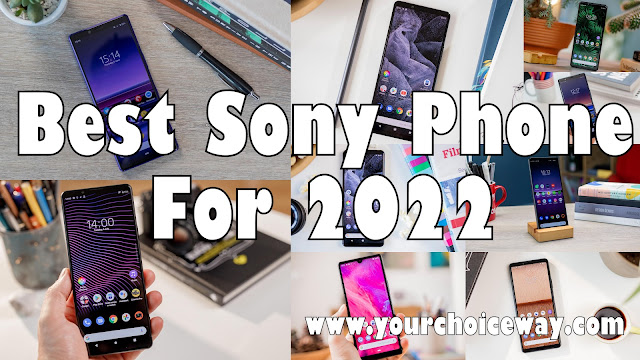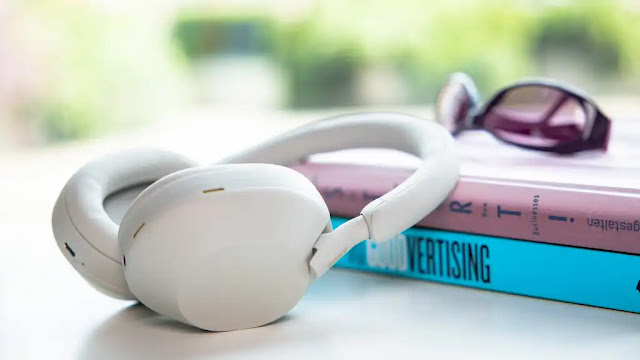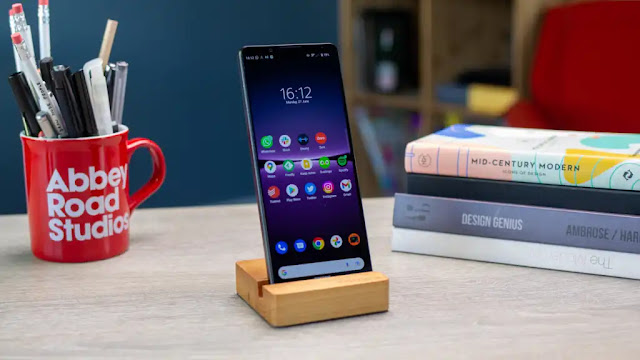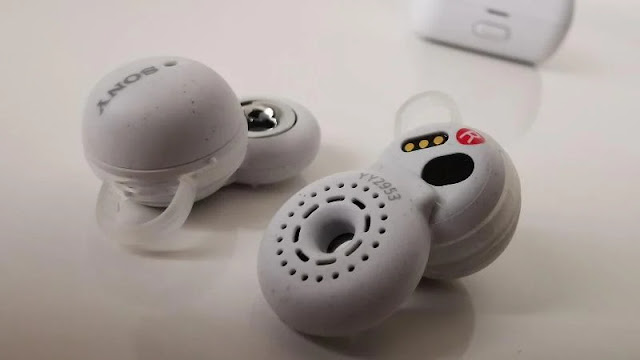The Xperia 10 II's unique talents are right for someone but its rivals offer greater mass-appeal
Should I Buy The Sony Xperia 10 II?
Pros
- A mid-ranger with water-resistance
- Slim, lightweight design
- Nice OLED display
Cons
- Underwhelming battery life
- No fast charger in-box
- Middling performance
Our Verdict
- The Sony Xperia 10 II is a mid-ranger with unique talents. If you're after an affordable phone with a 21:9 OLED display and/or IP65/68 water and dust resistance in a svelte, stylish design, the 10 II is for you.It can't, however, compete on matters of processing, battery or camera performance when placed against rival devices from the likes of Realme and Xiaomi.
Price When Reviewed
- N/A
Sony's smartphone release schedule has slowed to an absolute crawl in recent years, but that makes those times when a phone does hit the market all the more exciting. Queue the Sony Xperia 10 II - a phone with some unique flavour in an overcrowded mid-range market.
Last year's Xperia 10 and 10 Plus were middling mid-rangers, namely because of the ageing chipsets at their hearts, but also due to the fact that, beyond their elongated displays, they didn't do enough to differentiate themselves in a fiercely aggressive segment of the phone space.
The Xperia 10 II (that's pronounced "ten, mark two", for clarification - messy, but we'll move on) looks as though it's addressed many of its predecessors' shortcomings.
By being a singular device rather than 2019's twosome, the hope is that Sony has poured more energy into making this a more competitive phone outright. It's also granted the 10 II standout features that you seldom see at this price or in the mid-range market in general, not to mention it's a bit of a looker.
Refined And Resilient
If you like the flat glass faces, tight corners and general precision look and feel of last year's Xperia 1 (or, indeed, this year's Xperia 1 II), you'll appreciate the aesthetic at work on the 10 II too.
The 6in display, paired with the company's current taste for a 21:9 aspect ratio, makes a phone with a decidedly-big screen feel deceptively small. In a sense, it is small, or more specifically narrow, with a 69mm width and a respectable 8.2mm thickness that means most people will have no trouble comfortably gripping the 10 II in one hand. It's also wonderfully light, considering its size, at 151 grams.
While the frame running the phone's edge is plastic, it's expertly finished to remain consistent with the look of the rest of the phone, while also offering a nice hand feel. A subtle indent on the right side of the frame houses a signature Xperia power key-cum-fingerprint scanner - no awkward side-by-side placement here - which is as responsive and reliable as you could hope for.
The frame also houses a USB-C port, volume rocker, SIM tray and (perhaps most importantly) a 3.5mm headphone jack. Sony even went as far as including a pair of conventional wired in-ear buds in-box, just to hammer the port's inclusion home.
It's also worth noting that, unlike practically every other phone on the market, the SIM tray on the Xperia 10 II's left side doesn't require any additional tools to be opened or closed; made all the more impressive by the fact that this phone also boasts IP65/68 certification.
This means it can withstand being fully submerged in water for short periods of time, which is, it's worth noting, a trait of real scarcity in the mid-range market.
Related: Best mid-range phone 2020
Keep It Portrait And Wired
Another inclusion that isn't really a guarantee in the mid-range market is the use of an OLED display and Sony comes through again with the panel at play on the Xperia 10 II.
It's a 6in, 21:9 Full HD+ OLED Sony-brand 'Triluminous for mobile' panel that delivers on colours, contrast and viewing angles.
With entrants like the Realme 6 now out in the wild, there was some hope of a high refresh rate in-tow but Sony is notoriously slow to jump on such trends, meaning here it still ticks over at 60Hz.
Its mid-range standing means no HDR viewing either (even though the newly-announced, affordable Moto G 5G Plus offers HDR10 support) and maximum brightness could be better. Sony does at least include some handy customisation options as part of the viewing experience that run a little deeper than most devices around this price point.
You can choose between more accurate or more vivacious visuals, thanks to the 'Original' and 'Standard' viewing options, while a built-in video optimisation engine is just a tap away. The 10 II's display settings also offer robust white balance controls, with presets and independent channel sliders to toy with for those who like to tinker.
As for the phone's taller aspect ratio, it's less dramatic against the current phone landscape but brings the pros and cons of such a hardware choice into stark contrast.
While Sony's marketing highlights the display's ability to show 21:9 aspect ratio content (such as two-thirds of Netflix original movies) natively, in real-world use you're unlikely to watch media formatted in this way all that often.
Instead, you'll likely spend far more time streaming short-form content, like YouTube videos or TV series, which more often than not, adhere to a more traditional 16:9 (or, at a push, 18:9) aspect ratio. As such, just be ready for a lot of landscape content to appear pillar-boxed - with black bars running down on either side.
On the other hand, when using the phone in portrait, that tall display is undoubtedly a strength; letting you take in more content at once without having to scroll and, in the case of certain apps like Twitch, giving the UI more room to breath (the chat doesn't obscure full-screen streams when viewed in landscape, unlike on most other phones - as shown above).
There are also solid multitasking benefits here, with ample room for split-screen app usage and UI tweaks that make such functionality readily accessible - like one-tap access from the notifications shade from supported apps.
As for the audio side of things, the increasing rarity of the 3.5mm headphone jack makes its presence on the Xperia 10 II all the more appreciated, while Sony's staple inclusion of DSEE HX audio upscaling tech only helps elevate the port's inclusion for stalwart wired headphone users.
One sole criticism, audio-wise, would be a lack of stereo loudspeaker support; with a thin slit of speaker grille along the display's bottom bezel being the only outlet for some pretty flat and uninspiring sound.
Smart But Subtle Software Tweaks
The Xperia 10 II runs Android 10 out the box with Sony's decidedly-subtle embellishments on top. The company's toned down the number of tweaks it makes over the last few generations of its user experience, so, for the most part, the UI on the 10 II feels and behaves much like Google's own Pixel launcher.
A swipe up takes you to the apps tray, a swipe (or two) down lets you quickly check on notifications and quick-settings, instant access to Google is available via an ever-present search bar on your home screen and a dedicated Google page present after a single swipe right too.
The main alteration to the base Android experience is Side Sense, which has featured on Xperia devices for the last couple of years now.
A double-tap on the ever-present bar on the right side of the screen reveals a myriad of customisable shortcuts for apps and settings, as well as all-important features like split-screen and one-handed modes - essential when living with a device with a display as narrow and tall as the one on the 10 II.
Versatile Camera
One of the other failings of last year's Xperia 10 range were their cameras; particularly the smaller Xperia 10, which despite toting a dual-sensor setup like its larger sibling, opted for an underwhelming secondary depth sensor, which didn't add much to the base shooting experience.
Sony has taken a far more considered approach with the camera hardware at play on the Xperia 10 II. The triple-lens setup brings together a 12Mp main sensor, an 8Mp telephoto and an 8Mp ultra-wide angle sensor with a 120° FoV.
This makes for a more creative photography experience; granting you the ability to get different perspectives on the same subject, simply by jumping between the phone's lenses.
This alone is a step-up over last year and while the rest of the camera experience isn't going to blow your socks off, it's still a nice improvement over last year's mid-rangers.
 |
| Even with Night mode, the 10 II's low light credentials are lacking |
The main sticking points come in the form of noticeable shutter lag, underwhelming low-light performance and narrow dynamic range, particularly when using that ultra-wide sensor.
Despite these niggles, the general shooting experience beyond is respectable. Sony has a few creative modes to toy with and the ability to adjust the amount of bokeh in standard shots in-viewfinder at the point of capture is a nice inclusion that you seldom see on other mid-rangers.
In natural light, you're going to generally enjoy the shots that come out of the 10 II - they can sometimes look a little flat and a bright, cloudy day is going to give you the best results but generally speaking, it'll take Insta-worthy pics without too much work.
As for video, autofocus is a particular highlight, with object tracking built-in, making it easy to keep pets or kids in focus. Similarly to stills, footage can look a little flat but it's still wholly useable. Electronic image stabilisation, meanwhile, is present but drops out when pushing past Full HD resolution at 30 frames per second.
Usable But Not Competitive
As mentioned, the original Xperia 10 duo offered up middling performance, so the question is, "are things better this time around?" Technically "yes" but that comes with a big caveat - at least with regards to artificial benchmarks.
In testing, the phone's Snapdragon 665 chip and 4GB of RAM don't cut the mustard when placed against similarly-priced phones. In truth, the 665 is more commonly found in sub-£200 devices, like the Realme 5 and Oppo A9 (2020), making its appearance on the 10 II a little disappointing.
All that said, the phone feels responsive and snappy in real-world day-to-day usage, with select extended app load times and the occasional stutter hinting at the fact that Sony perhaps should have coughed up for a beefier processor/memory configuration when designing the 10 II.
A small but notable aside with regards to how the phone handles has to do with the vibration motor spinning away inside the Xperia.
Perhaps because of the phone's slim and lightweight design or perhaps simply because of the component Sony has opted for, any vibrations from the Xperia 10 II are outlandishly noisy, with a sudden high-pitched, piercing whine every time the motor spins up.
It's particularly bad when typing, as haptic feedback is enabled by default, meaning every keypress spins the motor faster and faster, louder and louder - vibration on a phone is meant to serve as a halfway house between having your ringer on and your phone being set to silent - the way it operates in the Xperia 10 II is anything but and should be turned off the moment you get your hands on the phone.
Fast(er) Charging
Sony was right to up the battery capacity compared to last year's Xperia 10 series; opting for a 3600mAh cell inside the 10 II. Based on the competition and rival devices hovering around the phone's price point, however, this is still only the bare minimum we'd expect from the company, from a competitive standpoint.
In PC Mark-based battery testing, it doled out a respectable 13 hours of benchmarking before reaching 20% (i.e. low battery), while real-world screen-on time (with auto-brightness enabled) clocked it at around four and a half to five hours per charge, which is just behind what we'd hoped for.
The Xperia 10 II does at least offer up to 18W fast charging, however, Sony once again skimps by putting a more conservative 7.5W charging in-box, meaning the phone makes it to just 28% after 30 minutes charge time.
If you want full-speed charging, you'll have to fork out for Sony's official 18W UCH32C fast charger (which isn't yet on sale but is expected to cost around £14.99). Alternatively, we tested with a compatible Power Delivery charger (the phone also supports Quick Charge 3.0) which at full speed filled the Xperia 10 II to a more satisfactory 41% within the same time frame.
Price & Availability
The Sony Xperia 10 II launched in various markets, including the UK, on 15 June. It's available SIM-free, direct from Sony's Xperia partner store (in a dual SIM configuration) for £319, as well as Amazon UK, for 95 pence more.
You can also pick it up on-contract from the likes of EE, O2, Virgin Mobile, Vodafone and Sky Mobile; with plans starting at £10 a month with no upfront cost.
Verdict
As ever with mid-tier devices like the Xperia 10 II, Sony has had to perform a tricky balancing act to produce a compelling, competitive phone that's comparable to its most similarly-priced rivals.
In a sense, the company has side-stepped a lot of direct comparison by including features that few other mid-rangers around the £320 asking price can match. Traits like its IP65/68 water and dust-resistance and that eye-catching 21:9 OLED display just don't appear on rival devices, and yet, in almost every other area that the phone is comparable, it falters.
The Xperia 10 II an unquestionable improvement over its two predecessors but the mid-range market has become even more fiercely competitive in the year since their launch; with companies like Realme and Xiaomi having a greater global presence and, it seems, more flexibility when it comes to price versus performance.
Notable rivals worth considering include the Huawei P30, Realme 6 Pro, Samsung Galaxy A51 and Xiaomi Redmi Note 9 Pro.
Specs
- 6in 21:9 Full HD+ OLED (2520x1080) display
- 12Mp wide + 8MP ultrawide (120°) + 8Mp 2x telephoto
- 8Mp front-facing camera
- IP65/IP68 dust & water resistance
- Corning Gorilla Glass 6
- 157x69x8.2mm
- 151g
- 3.5mm headphone jack
- Qualcomm Snapdragon 665 processor
- 4GB RAM
- 128GB storage + microSD up to 1TB
- Android 10
- 3600mAh battery
- Bluetooth 5.0
- USB-C
- NFC
- Side-mounted fingerprint sensor/power key






























%20Review.webp)

0 comments:
Post a Comment